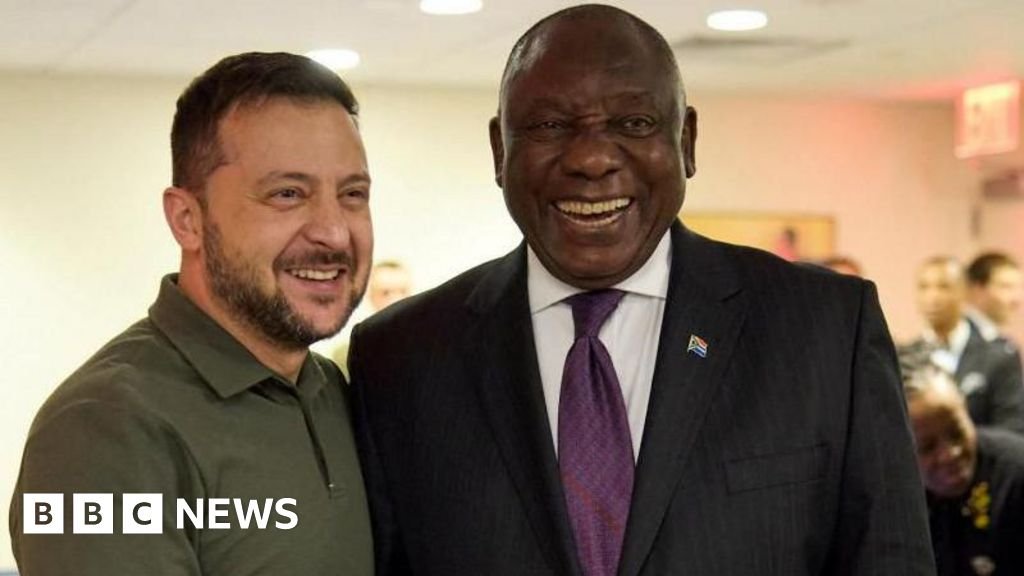Africa
Zelensky to Meet Ramaphosa in Bid to Counter Russian Influence

Historic Visit to South Africa
Ukraine’s President Volodymyr Zelensky is on a historic visit to South Africa, signaling a dramatic improvement in the once-strained relations between the two nations. This visit marks a diplomatic breakthrough for the Ukrainian leader in his efforts to counter Russia’s strong and growing influence in Africa.
Background of the Visit
The visit is significant, especially since this is Zelensky’s first visit to Africa since he became Ukraine’s president in 2019, apart from a brief stopover in Cape Verde in 2023. Ukraine has realized the importance of African states after many of them, including South Africa, refused to condemn Russia’s full-scale invasion of its territory in 2022.
Ukraine’s Shift in Foreign Policy
Ukraine has doubled its embassies in Africa from 10 to 20 over the last three years, indicating a significant shift in its foreign policy towards the continent. However, Ukraine faces stiff competition from other countries like Russia, China, Turkey, and the United Arab Emirates, which are also trying to increase their influence in Africa.
Significance of the Visit for Ukraine
The visit is crucial for Ukraine, especially since its relationship with the US, its main weapons supplier, has soured under President Donald Trump. Trump has paused military aid to Ukraine, denounced Zelensky as a "dictator," and accused Ukraine of being responsible for the war. Therefore, Ukraine needs to gain legitimacy internationally, not just in Europe, to counter Russia’s influence.
Significance of the Visit for South Africa
The visit is equally significant for South Africa’s President Cyril Ramaphosa, as his country is under intense pressure from the Trump administration. Ramaphosa sees Zelensky’s visit as an opportunity to boost his credentials as a peacemaker and has announced that their talks will focus on finding "a path to peace" in the Russia-Ukraine conflict.
South Africa’s Role in the Conflict
Ramaphosa had previously attempted to mediate an end to the conflict in 2023 by leading a delegation of African leaders to both Kyiv and Moscow. South Africa has maintained its neutrality in the conflict, despite facing a backlash from the US. The country has also faced allegations of supplying arms and ammunition to Russia, which were later found to be baseless.
Expected Outcomes of the Visit
The visit is expected to strengthen trade ties between South Africa and Ukraine, which could benefit both countries. South Africa’s economy is in crisis, with low growth and high unemployment, and any volume of trade, no matter how small, is critical for the country. Strong relations between the two nations could also benefit Ukraine in its efforts to extend its influence on the continent.
Gateway to Africa
South Africa could be Ukraine’s gateway to Africa due to its ports and financial systems. However, this does not necessarily mean that Africa will choose sides between Russia and Ukraine, as both countries are significant exporters of cereals to the continent.
Conclusion
In conclusion, Zelensky’s visit to South Africa marks a new chapter in Ukraine-Africa relations. The visit is significant for both countries, as they seek to strengthen their ties and counter the influence of other nations in the region. While the visit is expected to have positive outcomes for both countries, it remains to be seen how it will affect the delicate balance of power in the region and the ongoing conflict between Russia and Ukraine.
Africa
Al-Shabaab Battles Somali Army for Control of Strategic Base

Recent Clashes in Somalia
Introduction to the Conflict
Mogadishu — Al-Shabaab fighters are engaged in a fierce battle with Somali troops and allied forces for control of a strategic army base in central Somalia. The al-Qaeda linked militants are attempting to extend their recent gains in the region. The base, located in Wargaadhi town in the Middle Shabelle region, houses soldiers, special forces, and clan fighters.
The Importance of the Base
Capturing the base would enable al-Shabaab to sever an important trunk road between the capital Mogadishu, 200km to the southwest, and Galmudug state. This would give the militants a significant advantage in terms of controlling the flow of people and goods in the region.
The Battle for Control
Al-Shabaab claimed in a statement that its fighters had captured the base and Wargaadhi town, but the government denied this. The information ministry said that government forces had killed more than 40 jihadists after they attempted to attack the base on Thursday morning. However, army officer Hussein Ali said that the militants had taken the town of Wargaadhi after “fierce fighting”. According to Ali, the government forces lost 12 men, mostly clan fighters, and about 20 al-Shabaab fighters were also killed.
Challenges Faced by the Government
The government is struggling to send reinforcements to the area because they would need to use routes passing through areas held by al-Shabaab. Two soldiers said that the government forces, backed by air strikes, had managed to recapture part of the town by midmorning. However, the situation remains uncertain, and it is difficult to verify the claims made by either side about the fighting.
Background to the Conflict
Al-Shabaab has been waging an insurgency in Somalia since 2007 to seize power. Last week, the group attacked the town of Adan Yabal, about 245km north of Mogadishu, which the military had been using as an operating base for raids on the group. The attacks are part of an offensive by the group launched last month. Al-Shabaab briefly captured villages within 50km of Mogadishu, raising fears among residents of the capital that the city could be targeted.
International Support
Somali forces have since recaptured those villages, but al-Shabaab has continued to advance in the countryside. The future of international security support to Somalia appears increasingly precarious. A new AU peacekeeping mission replaced a larger force at the start of the year, but its funding is uncertain, with the US opposed to a plan to transition to a UN financing model.
Conclusion
The situation in Somalia remains volatile, with al-Shabaab continuing to launch attacks and gain control of strategic areas. The government and international community must work together to provide support and stability to the region. The fate of Somalia hangs in the balance, and it is crucial that the international community takes action to prevent the spread of extremism and promote peace and stability in the region.
Africa
These Apes Are Matriarchal, but It Doesn’t Mean They’re Peaceful

Introduction to Bonobos
Male domination is often seen as the natural order of things, but bonobos, our closest living relatives, challenge this notion. Bonobos are great apes that live in female-dominated societies, a rarity among mammals. They share nearly 99 percent of their DNA with humans and offer a unique perspective on social dynamics.
The Social Structure of Bonobos
Bonobos live in communities where females reign supreme, despite being smaller than their male counterparts. Scientists have long been fascinated by how female bonobos maintain their dominance. A recent study published in the journal Communications Biology provides the first evidence-based explanation. The study found that females form coalitions to overpower males, resulting in higher social ranks for the winning females.
How Female Bonobos Maintain Power
When a male bonobo steps out of line, nearby females will band together to attack or intimidate him. Males who cower in the face of such conflicts lose social rank, while their female adversaries gain it. This coalition-building strategy allows females to access better food and secure mates for their sons. The average female bonobo outranks approximately 70 percent of the males in her community.
Studying Bonobos in the Wild
Bonobos are endangered and found only in the Democratic Republic of Congo, making them difficult to study in the wild. Researchers spent thousands of hours tracking six bonobo communities over nearly 30 years. They observed 1,786 instances of males starting conflicts with females, and in roughly 61 percent of these fights, the females emerged victorious.
Challenging the Stereotype of Peaceful Bonobos
Bonobos are often stereotyped as peaceful and loving, but observations by researchers challenge this notion. Conflicts between the sexes can be severe, with males losing fingers and toes, and even suffering more severe injuries. The idea that bonobos are the "hippies of the ape world" is an oversimplification of their complex social dynamics.
The Importance of Female Coalitions
The study’s findings support the "female coalition hypothesis," which suggests that females work together to overpower males during conflicts. This strategy is key to maintaining female dominance in bonobo society. The data collected by researchers affirms what scientists have suspected for decades about the source of female power in bonobo society.
Lessons from Bonobos
The study of bonobos offers valuable insights into social dynamics and challenges the idea that male dominance is a biological inevitability. By protecting bonobos and their habitats, we can continue to learn from them and gain a deeper understanding of our own evolutionary past.
Conclusion
The study of bonobos provides a unique perspective on social dynamics and challenges traditional notions of male dominance. By examining the complex social structures of bonobos, we can gain a deeper understanding of our own evolutionary past and the importance of cooperation and coalition-building in maintaining social balance. As our closest living relatives, bonobos offer a valuable mirror for humanity, and their protection is crucial for preserving our shared evolutionary heritage.
Africa
Tanzania Bans Imports From South Africa and Malawi Amid Trade Row

Trade Row Escalates Between Tanzania, South Africa, and Malawi
Tanzanian traders have been ordered to halt all shipments to South Africa and Malawi in the latest episode of a growing trade row. The move comes after Malawi temporarily blocked imports of flour, rice, ginger, bananas, and maize from Tanzania, while South Africa has prohibited the entry of bananas from Tanzania for years.
Background of the Trade Dispute
Diplomatic efforts to resolve the trade issues have so far failed, but fresh talks are ongoing. The row comes at a time when Africa is supposed to be moving towards greater free trade through the establishment of a continent-wide free-trade area, which began operating four years ago. Tanzania’s Agriculture Minister, Hussein Bashe, confirmed the move, stating that "we are taking this step to protect our business interests. This is business – in business, we must all respect each other."
Impact on Trade
South African exports of various fruits, including apples and grapes, to Tanzania will be hit. Meanwhile, landlocked Malawi, which has relied on Tanzanian ports to carry its exports such as tobacco, sugar, and soybeans to the rest of the world, will have to reroute its goods. Malawi’s ban on the import of certain produce, announced in March, was designed as a temporary measure covering goods from all countries to protect local producers, according to the authorities in Lilongwe.
Tanzania’s Response
Tanzania’s agriculture minister said Malawi’s move had "directly affected" his country’s traders and described the restrictions as "unfair and harmful." While confirming the import ban, Bashe assured Tanzanians that it would not threaten their food security. "No Tanzanian will die from a lack of South African grapes or apples," he said, adding that "we are taking these actions to protect Tanzanian interests."
Effects on Border Trade
On Thursday, the usually busy Kasumulu border post linking Tanzania and Malawi remained quiet, with only a handful of lorries transporting cargo such as fuel spotted on the Tanzanian side. On a normal day, more than 15 lorries loaded with agricultural produce would cross the frontier between the two countries, drivers told BBC. On the Malawian side, many lorries that should be transporting bananas and tomatoes through Tanzania were parked and empty.
Alternative Routes
Malawi has become an increasingly important market for Tanzanian goods in recent years, with exports trebling between 2018 and 2023, according to official Tanzanian figures. But while Tanzania can seek alternative markets such as in Kenya, Namibia, and South Sudan, Malawi may find it harder to get its goods out of the country. Much of its exports go through the Tanzanian port of Dar es Salaam, as well as essential imports such as fuel and machinery. Losing access to Dar es Salaam would likely force Malawi to move shipments through the Mozambican ports of Beira and Nacala – options that may be more expensive.
Conclusion
The trade row between Tanzania, South Africa, and Malawi has significant implications for the region’s economy and trade relationships. While Tanzania’s move is intended to protect its interests, it may lead to a trade war that could harm all parties involved. The situation highlights the need for diplomatic efforts to resolve trade disputes and promote regional cooperation. As Bashe argued, "Tanzania will not continue to allow unequal market access to persist at the expense of its people." The outcome of this trade row will be closely watched, and its impact on the region’s trade and economic development will be significant.
-

 South Sudan1 week ago
South Sudan1 week agoNo Political Motive in Giada Shootout
-

 South Sudan1 week ago
South Sudan1 week agoBor Youth Petition for Wildlife Force Relocation Amid Tensions
-

 South Sudan1 week ago
South Sudan1 week agoWestern Equatoria Launches Peace Initiative for Youth and Women
-

 Sudan1 week ago
Sudan1 week agoSudan Army Thwarts RSF Drone Attacks
-

 Africa1 week ago
Africa1 week agoMali Officials Shut Down Barrick Gold’s Office Amid Tax Dispute
-

 World News1 week ago
World News1 week agoSyrians Destroy Assad’s Icons
-

 Africa1 week ago
Africa1 week agoInvestment App Freezes Users Out, Sparking Savings Loss Fears
-

 Sudan2 weeks ago
Sudan2 weeks agoSSOA Forces Defect to Kiir in Large Numbers








You must be logged in to post a comment Login